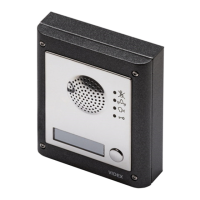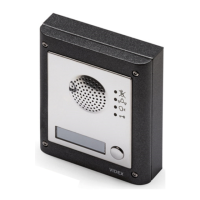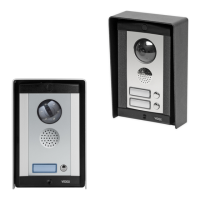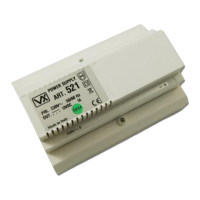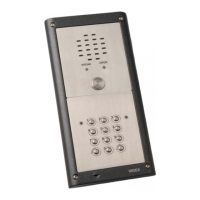66250754-4G-EN - V2.0 - 28/03/22
- 52 -
4000 Series GSM Audio Intercom - Technical Manual
4000 Series GSM Audio Intercom with Proximity
PROXIMITY NUMBER OF BYTES TO CHECK PBY, 02, 03 & 04
This function of the built-in proximity reader will only be applicable if the proximity reader has been enabled (see EPR function on
the previous page). After the proximity reader is enabled the number of bytes that the reader checks is dependant on which type of
proximity fob/card is used (also refer to the GSMSK PC software manual GSMSK_66251720-EN_V2-1 or later).
Understanding the Fob Format and Card Number
It is important to understand the relationship between the fob format and the card number when setting up the proximity reader
to check for the correct number of bytes.
• Fobs/Cards with 5 digit number (user code): If a proximity fob/card has no site code but a 5 digit user code
(e.g. 955/T or 955/C) the PBY format should be set to check for 2 bytes (02).
• Fobs/Cards with 3 digit site code and 5 digit user code: If using a fob/card with a 3 digit site code and 5 digit
user code (e.g. PBX1E or PBX2) the PBY format can be set to check for 2 bytes (02) or 3 bytes (03).
• Fobs/Cards programmed using the PROXE or PROX-USB desktop reader: If using a desktop reader the PBY
format can be set to check for 2 bytes (02), 3 bytes (03) or 4 bytes (04).
The default setting for this function is set to check for 2 bytes, ‘02’. The following texts can be used to change this setting.
1111PBYnn Set proximity reader to check for number of bytes nn: 02, 03 or 04 (02 = check for 2 bytes, 03 =
check for 3 bytes, 04 = check for 4 bytes).
1111PBYnn? As above and send a conrmation text back to the sender.
1111PBY? Query the number of bytes that the GSM has been set to check for.
PBY setting Description
2 bytes Will read all fobs/cards types programmed.
3 bytes Will not read fobs/cards programmed with only 2 bytes (5 digit) information.
4 bytes Will not read fobs/cards programmed with only 2 bytes (5 digit) or 3 bytes (8 digit) information.
IMPORTANT NOTE: It is recommended that only one fob/card type is used (i.e. 955/T or PBX-1E etc.) to allow for easier set up
and programming of the GSM reader. Mifare cards cannot be used.
STORE A PROX FOB/CARD TO A KNOWN LOCATION 000 999 OR STORE IN THE NEXT AVAILABLE LOCATION FOB
Once the built-in proximity reader or expansion reader (Art.4850R) has been enabled and the number of bytes to check for has
been set (refer to the EPR and PBY setup described above) the proximity fobs/cards can be programmed into the GSM intercom.
The GSM intercom can store up to 1000 fobs/cards (000 - 999). Both the built-in reader and expansion readers (Art.4850R) can be
programmed with any one of the following fobs:
• 955/T or 955/C = Videx fobs or cards. These fobs and cards have no site code and have a 5 digit user code, so
the PBY function must be set to 02 (the default setting, checking for 2 bytes).
• PBX1E or PBX2 = Portal Plus fobs or cards. These fobs and cards have a 3 digit site code and 5 digit user code,
so the PBY function can be set to 02 or 03.
The following texts can be used to program fobs or cards to a known memory location.
1111FOBnnn”site”,”user”
or
1111FOBnnn”site”,”user”?
Store fob/card in location nnn, where nnn = the memory location from 000 - 999 of where the
fob/card is actually stored (see examples below for each type of fob/card). The “site” and “user”
code is the number taken directly from the fob/card. Including the ? at the end of the command
will send a conrmation text back to the sender.
1111FOBnnn? Query the fob/card stored in memory location nnn and send a conrmation text back to the
sender with the stored fob/card details.
The following examples show how to program each fob/card type:
Example 1:
Programming a 955/T or 955/C with no site code, a 5 digit user code of 12345 and storing it in memory location 001, the
following text can be sent to the GSM intercom:
1111FOB001”0”,”12345”
For these fob/card types a 0 must be inserted for the “site” code.
Example 2: Programming a PBX1E or PBX2 with a 3 digit site code of 123, a 5 digit user code of 45678 and storing it in memory
location 010, the following text can be sent to the GSM intercom:
1111FOB010”123”,”45678”
Expanding on the FOB programming command it is also possible to store a fob or card into the next available memory location.
Programming the GSM Intercom
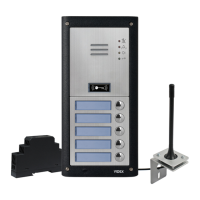
